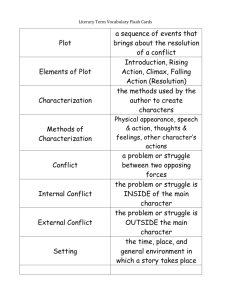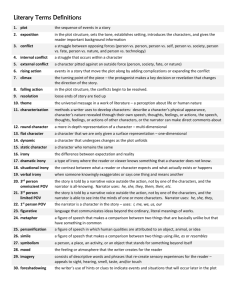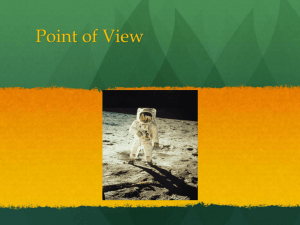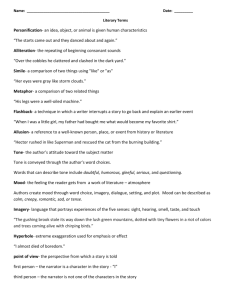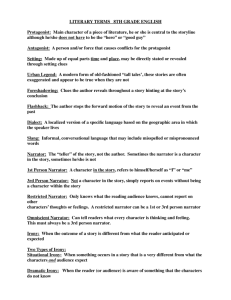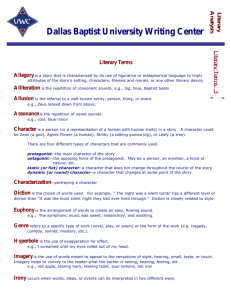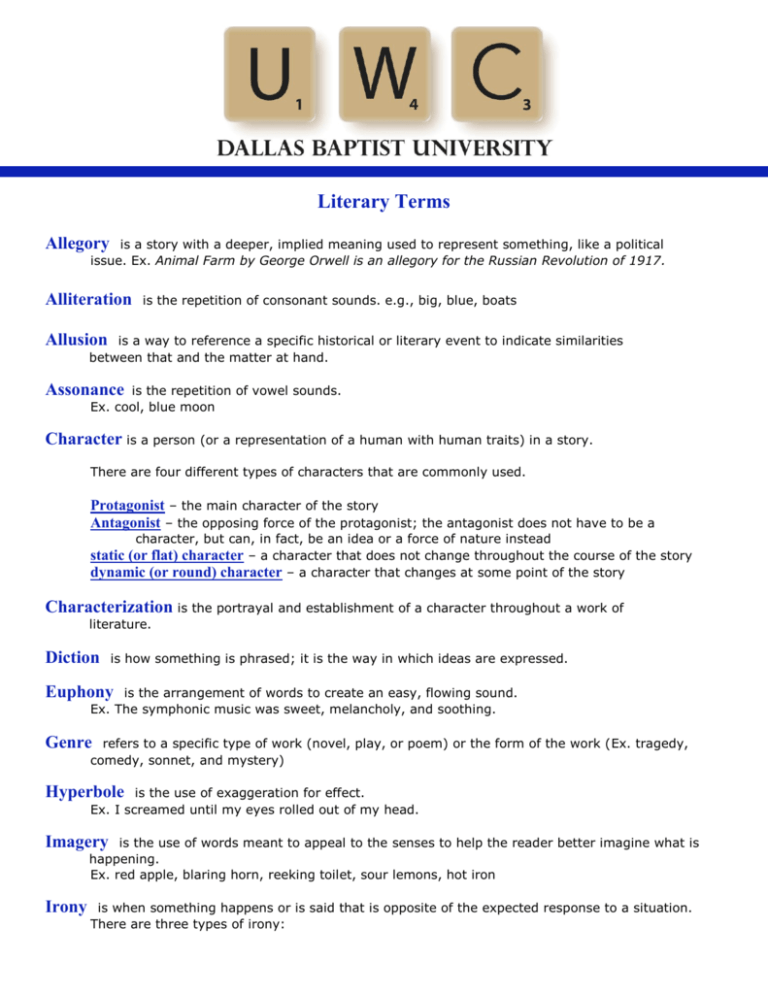
Literary Terms
is a story with a deeper, implied meaning used to represent something, like a political
issue. Ex. Animal Farm by George Orwell is an allegory for the Russian Revolution of 1917.
Allegory
Alliteration
is the repetition of consonant sounds. e.g., big, blue, boats
is a way to reference a specific historical or literary event to indicate similarities
between that and the matter at hand.
Allusion
is the repetition of vowel sounds.
Ex. cool, blue moon
Assonance
Character is a person (or a representation of a human with human traits) in a story.
There are four different types of characters that are commonly used.
Protagonist – the main character of the story
Antagonist – the opposing force of the protagonist; the antagonist does not have to be a
character, but can, in fact, be an idea or a force of nature instead
static (or flat) character – a character that does not change throughout the course of the story
dynamic (or round) character – a character that changes at some point of the story
Characterization is the portrayal and establishment of a character throughout a work of
literature.
Diction
is how something is phrased; it is the way in which ideas are expressed.
is the arrangement of words to create an easy, flowing sound.
Ex. The symphonic music was sweet, melancholy, and soothing.
Euphony
refers to a specific type of work (novel, play, or poem) or the form of the work (Ex. tragedy,
comedy, sonnet, and mystery)
Genre
is the use of exaggeration for effect.
Ex. I screamed until my eyes rolled out of my head.
Hyperbole
is the use of words meant to appeal to the senses to help the reader better imagine what is
happening.
Ex. red apple, blaring horn, reeking toilet, sour lemons, hot iron
Imagery
Irony
is when something happens or is said that is opposite of the expected response to a situation.
There are three types of irony:
verbal irony — saying one thing and meaning another.
Ex. clear as mud
dramatic irony — when the reader knows more than the characters know,
Ex. when the audience knows about the outcome of an event before the characters in the
story, who expect a different result
situational irony — when a situation occurs in which the outcome is different than what was
expected
is everything that is written and spoken. Literature includes four
categories: fiction, non-fiction, poetry, and drama.
Literature
is a figure of speech that relates something to the reader by use of comparison, without
“like” or “as”.
Ex. “The sun’s light was a bath of heat from the sky.” In this case, the sun’s light is not an actual
bath, but it is being compared to a bath.
Metaphor
are devices authors use to vary storytelling style. These techniques include
things such as flashbacks, foreshadowing, and recurring themes.
Narrative Techniques
is the use of words that sound like the noise they describe.
Ex., buzz, crash, tink
Onomatopoeia
is a statement that is contradictory or opposed to common sense, but is true.
Ex. jumbo shrimp
Paradox
is giving a non-human thing human attributes.
Ex. The tree waved her arms in the wind.
Personification
Plot
is the sequence of events in a story, poem, or play.
There are usually five parts that make up a complete plot.
Exposition – the introduction to the story that provides all necessary information at the present
time for the plot to develop
Conflict – the struggle between opposing forces
Rising action/complication/crisis – when the normal flow of things is disrupted by the conflict(s)
Climax – the highest point of the conflict when tension is at its maximum
Resolution/falling action/denouement – when the conflict is over and things get resolved
Poetry
is a genre which is characterized by rhythmical qualities of language.
Point of view
is the position from which the teller of the story sees and relates the story.
Five different points of view are used.
First-person narrator — The narrator is part of the action, but has limited
knowledge of the other characters.
Second-person narrator — The narrator tells the reader what “you” are doing:
“You step towards the lion.” This form is typically reserved for “Choose Your Own
Adventure” books and should never be used in academic writing.
Third-person objective narrator — The unidentified narrator is not part of the action and reports
only what can be seen and heard.
Third-person omniscient—The narrator is all-knowing and tells all the characters’ thoughts and
feelings.
Third-person limited omniscient—The narrator is all-knowing about only one character.
is formed by words that have the same ending sound or sound(s). Traditionally, the rhyme is at
the end of the line. For example, Tennyson wrote in his poem, The Lady of Shallot, "And when the
moon was overhead/Came two young lovers lately wed,/'I am half sick of shadows,' she said."
Rhyme
is the beat of poetic lines expressed by the pattern of stressed and unstressed syllables.
For example, Robert Frost wrote his poem, Stopping by Woods on a Snowy Evening, in iambic
tetrameter, consisting of alternating unstressed and stressed syllables.
Rhythm
"Whose woods these are I think I know.
His house is in the village though;
He will not see me stopping here,
To watch his woods fill up with snow."
Setting
is the place and the time in which the story happens.
is a comparison between two things that is marked by the use of "like" or "as."
Ex. “her face is like a beautiful rose.”
Simile
Stories
are accounts of events and happenings in certain situations.
is the way the plot is organized or arranged. The way a story is structured helps to set
the tone and mood of the story, as well as how the plot and theme are perceived.
Structure
Style
is the way language is used to relate the story to the reader. The helps the work of literature
appeal to different people in different ways. For example, George Orwell’s writing of an Orwellian
society in 1984 may not be as appealing to some as Suzanne Collin’s portrayal in the Hunger
Games.
is the use of an object or an idea to represent another idea, value, or object.
Ex. A flower budding in a meadow of dead flows could represent the idea of rebirth or new birth.
Symbolism
Syntax
is the order of words and the way the sentences are arranged.
is the central idea, argument, or underlying point of a work of literature. Examples of themes
could be “Love grows as a couple matures,” “A wise person is patient,” “No one can escape death,”
or “Be careful what you ask for because it may come true.”
Theme
Tone
is created by the style in which the story, poem, play, or essay is delivered and sets the mood of
the work.
Original material copyright © Dallas Baptist University. All rights reserved. Other copyrighted material included by permission or
authorization. Created by UWC Staff for Dallas Baptist University. http://www.dbu.edu/uwc. August 2015.


